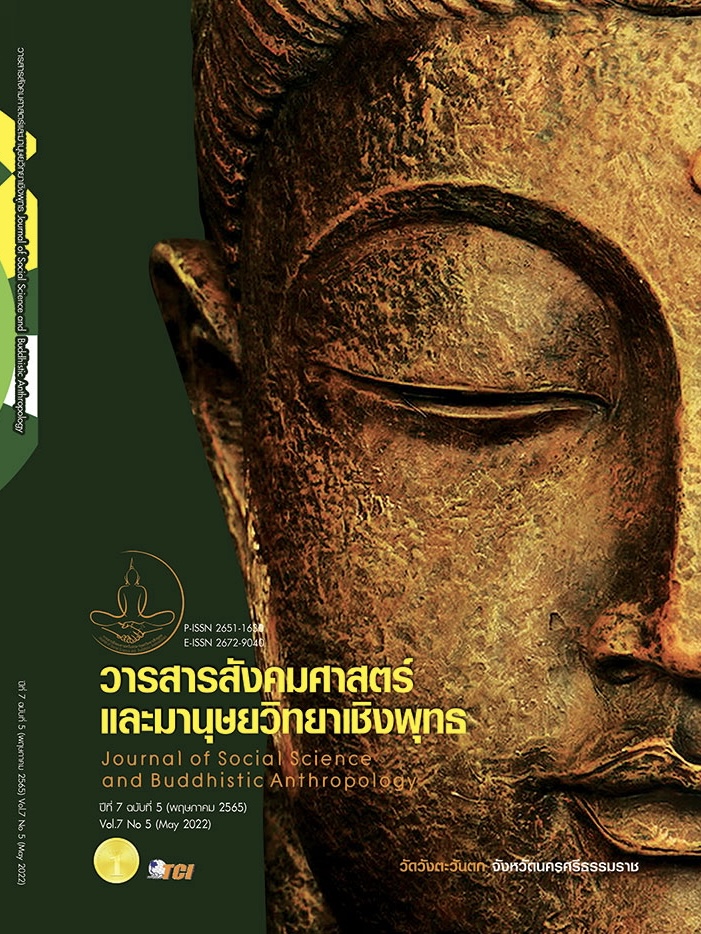DEVELOPMENT THE COMMUNICATION MODEL BETWEEN COMMUNITIES TO QUIT AGROCHEMICALS IN LOEI PROVINCE
Keywords:
Communication Between Communities, Participation, Agricultural Chemicals, Strategic Plan to Stop Using Agricultural ChemicalsAbstract
The objectives of this research article were to: 1) study the problem of agricultural chemical use that affects human health and environment in Loei Province. 2) build a determination to stop using chemicals in agriculture by means of communication in community. 3) bring a model group that has stopped using agricultural chemicals to practice in the community with participation in the work. 4) create a communication model in the community with the model community being the one who expands the results to other communities. This study used a participatory action research (PAR) method by collecting quantitative and qualitative data on site, Wangsaphung District, Loei Province. The quantitative research method used a questionnaire to collect data on the use of agricultural chemicals farmers in the area of Wangsaphung District and analysed the results by using percentage statistics. As for the qualitative research, the public participation process was used in Pha Bing Sub-district, Wangsaphung District by allowing the sample groups to collaborate in making a strategic plan which composed of project plans. Then, people have implemented the project until the use of agricultural chemicals was stopped. The results showed that the quantitative data gave people an overview of the use of a large number of agrochemicals and their impacts on health until people in the community were willing to develop a communication model of the community as a model community to create an expansion to other communities. According to communication mechanisms between communities that make communication successful, there must be communication components in the communication process, composed of 4 components: the messenger, the message content, the communication channel and the receiver, which must be adapted to suit the characteristics of people and areas due to limitations and differences in each community.
References
กองโรคจากการประกอบอาชีพและสิ่งแวดล้อม กรมควบคุมโรค. (2563). การดําเนินงานเฝ้าระวัง ป้องกัน ควบคุมโรคและภัยสุขภาพสําหรับแรงงานนอกระบบ ประจําปี 2563. เรียกใช้เมื่อ 22 มิถุนายน 2564 จาก http://envocc.ddc.moph.go.th/uploads/galleries3/202105/pdf/20210507_02.pdf
เครือข่ายเตือนภัยสารเคมีกำจัดศัตรูพืช Thai-PAN. (2564). ปริมาณการใช้สารเคมีกำจัดศัตรูพืชของไทยอยู่อันดับไหนของโลก. เรียกใช้เมื่อ 8 กันยายน 2564 จาก https://thaipan.org/highlights/2426
สำนักงานสาธารณสุขจังหวัดเลย. (2561). สสจ พบคนเมืองเลยมีสารเคมีในเลือดมากเกินปกติ สูงถึง 35 เปอร์เซ็นต์. เรียกใช้เมื่อ 12 พฤศจิยายน 2561 จาก https://www.matichon.co.th/news-monitor/news_1142193
Bureau of Plant and Agricultural Materials Control. (2020). Summary of Hazardous Substances of 2020. Retrieved November 28, 2021, from https://www.doa.go.th/ard/?page_id=386
Department of Disease Control. (2012). Annual performance report 2012. Nontaburi: Ministry of Public Health.
Dutta, A. (2016). C3 A Model of Community Communication. Retrieved January 26, 2016, from https://www.slideshare.net/ankurandutta/c3-a-model-of-community-communication
Fernández, L. (2019). GMP-Compliant Manufacturing of NKG2D CAR Memory T Cells Using CliniMACS Prodigy. Frontiers in Immunology Journal, 10(2), 1-12.
Kaewthep, K. (2008). Basic knowledge management on "Community Communication". Bangkok: The Thailand Research Fund.
Koch, T. & Kralik, D. (2006). Participatory Action Research in Health Care. London: Wiley-Blackwell.
MacDonald, C. (2012). Understanding Participatory Action Research: A Qualitative Research Methodology Option. Canadian Journal of Action Research, 13(2), 34-50.
Mahmood, I. et al. (2016). Effects of Pesticides on Environment. In Hakeem, K., Akhtar, M. and Abdullah, S. (Eds.). Plant, Soil and Microbes (pp. 256-269). Springer, Cham: Springer Nature.
Marshall, C. & Rossman, G. (2016). Designing Qualitative Research. (6th Edition). Thousand Oaks: Sage Publications.
Minkler, M. (2012). Community-Based Participatory Research: A Strategy for Building Healthy Communities and Promoting Health Through Policy Change. Carlifonia: PolicyLink.
Phuangsomjit, C. (2014). Participatory Action Research on Research in Educational Administration. (Book 2 (Unit 6-10); 3rd edition). Bangkok: Sukhothai Thammathirat Open University.
Reason, P. & Bradbury, H. (2008). The Sage Handbook of Action Research. London: Sage Publications.
Sabarwal, A. et al. (2018). Environmental Toxicology and Pharmacology. Environ Toxicol Pharmacol, 63(2018), 103-114.
UNHCR: The United Nations High Commissioner for Refugees. (2016). Communicating with Communities. Retrieved December 26, 2016, from https://www.unhcr.org/innovation/communicating-with-communities/
Worldometers. (2017). Pesticides-by-country. Retrieved November 21, 2018, from https://www.worldometers.info/food-agriculture/pesticides-by-country/
Downloads
Published
How to Cite
Issue
Section
License
Copyright (c) 2022 Journal of Social Science and Buddhistic Anthropology

This work is licensed under a Creative Commons Attribution-NonCommercial-NoDerivatives 4.0 International License.








